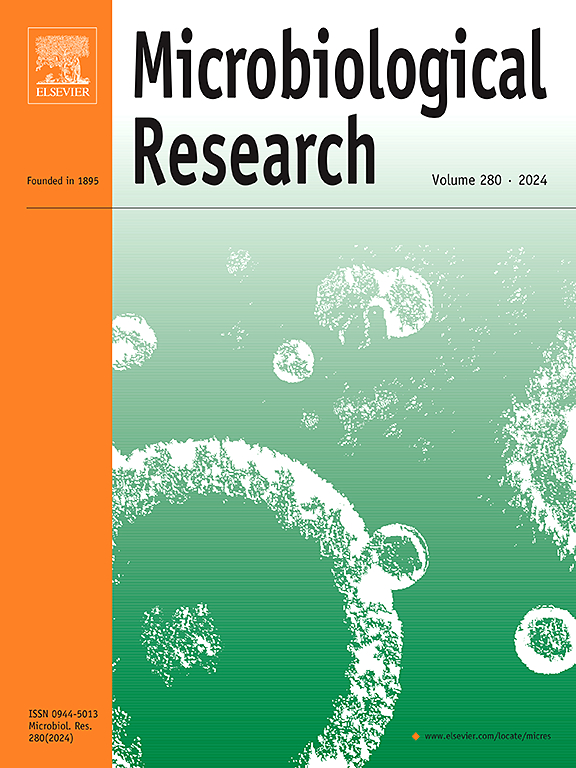内生真菌细菌:新出现的范例和未来的方向
IF 6.9
1区 生物学
Q1 MICROBIOLOGY
引用次数: 0
摘要
细菌对真菌菌丝和孢子的定植代表了一种广泛的现象,在所有被调查的真菌门类中具有重要的生态和生物技术意义。最初被认为仅限于Mollicutes和burkholderacae相关的内细菌,这些内真菌关联表现出显著的多样性,从简单的均匀种群到复杂的群落,与早期的均匀种群假设相矛盾。获取动力学证明了古老的共同进化关系和最近的水平转移事件,即使在同一真菌物种中,环境因素也驱动了共生存在的菌株水平变化。真菌可以容纳统一或多样的细菌群落,有时在专门的结构中,并表现出不同程度的依赖于它们的共生体。这些相互作用可以是互惠的、共生的或寄生的,影响真菌的生理、代谢和生态功能。然而,其潜在机制仅在少数模型系统中得到了彻底的表征,在这些模型系统中,内真菌细菌已被证明影响营养获取、应激耐受性、次生代谢物产生,甚至真菌致病性。作为回报,真菌提供了一个保护性的生态位并促进了扩散。这些概念共同说明了陆地生态系统中真菌-细菌伙伴关系的进化灵活性和生态重要性。这篇综述综合了内真菌细菌研究的新范式,整合了最近的发现,挑战了关于这些共生关系的传统假设。我们研究了宿主特异性模式、获取机制和功能影响,同时确定了需要调查的关键知识空白。深入了解这些关联对于建立标准化框架以将其应用于农业、医学和环境可持续性至关重要。本文章由计算机程序翻译,如有差异,请以英文原文为准。
Endofungal bacteria: Emerging paradigms and future directions
The colonization of fungal hyphae and spores by bacteria represents a widespread phenomenon with significant ecological and biotechnological implications across all surveyed fungal phyla. First thought to be restricted to Mollicutes and Burkholderiaceae-Related Endobacteria, these endofungal associations exhibit remarkable diversity, from simple uniform populations to complex communities, contradicting earlier assumptions of uniform populations. Acquisition dynamics demonstrate both ancient co-evolutionary relationships and recent horizontal transfer events, with environmental factors driving strain-level variation in symbiont presence even within the same fungal species. Fungi can harbor either uniform or diverse bacterial communities, sometimes within specialized structures, and exhibit varying degrees of dependence on their symbionts. These interactions can be mutualistic, commensal, or parasitic, influencing fungal physiology, metabolism, and ecological function. Yet the underlying mechanisms have been thoroughly characterized in only a few model systems in which endofungal bacteria have been shown to affect nutrient acquisition, stress tolerance, secondary metabolite production, and even fungal pathogenicity. In return, fungi offer a protective niche and promote dispersion. These concepts collectively illustrate the evolutionary flexibility and ecological importance of fungi-bacteria partnerships across terrestrial ecosystems.
This review synthesizes emerging paradigms in endofungal bacteria research, integrating recent discoveries that challenge traditional assumptions about these symbioses. We examine host specificity patterns, acquisition mechanisms, and functional impacts while identifying critical knowledge gaps requiring investigation. A deeper understanding of these associations is essential to establish standardized frameworks for their applications in agriculture, medicine, and environmental sustainability.
求助全文
通过发布文献求助,成功后即可免费获取论文全文。
去求助
来源期刊

Microbiological research
生物-微生物学
CiteScore
10.90
自引率
6.00%
发文量
249
审稿时长
29 days
期刊介绍:
Microbiological Research is devoted to publishing reports on prokaryotic and eukaryotic microorganisms such as yeasts, fungi, bacteria, archaea, and protozoa. Research on interactions between pathogenic microorganisms and their environment or hosts are also covered.
 求助内容:
求助内容: 应助结果提醒方式:
应助结果提醒方式:


